Over the 2023-2024 academic year, the Sustainable City Year Program (SCYP) is harnessing the University of Oregon’s wide-ranging talents to address community needs.
Salem is the first city SCYP has returned to in its 14-year history partnering with Oregon cities. Student learning opportunities focus on real city projects covering a wide range of disciplines from architecture, landscape architecture, planning, public administration, journalism, geography, and business. “As the state capital and the second largest city in Oregon, there are aspects of Salem that I think are magnified in a lot of ways for our students,” Megan Banks, SCYP program director said. “The potential with this partnership in the breadth of everything they’re trying to accomplish – it’s astounding, actually, in a lot of ways.”
Throughout the year, students from up to 20 courses will work on projects to help implement the city’s climate action plan and equity goals. This year’s SCYP partnership is possible in part due to support from U.S. Senators Ron Wyden and Jeff Merkley, as well as former Congressman Peter DeFazio, who secured federal funding for SCYP through Congressionally Directed Spending. With additional funding from the city, the partnership will allow UO students and faculty to investigate and make recommendations on city-identified projects and issues.
Courtney Knox Busch, Salem’s strategic initiatives manager, said the student work will advance council and community priorities faster than the city could do on its own. As someone who previously studied public policy in college, she’s happy to help students apply their learning. “To me, it’s just so powerful from all perspectives. The community wins, the students win, and the city just advances further,” she said. “So, I think it’s fabulous.”
Discover the transformative power of student work that occurred this fall term through seven distinct courses across four disciplines to develop new ideas and advance city goals.
SCYP Fall Term Course Recap:

Faculty: Nancy Cheng, University of Oregon and Mariapaola Riggio, Oregon State University
Project: Parks and Recreation Structures
Outcome: Timber Tectonics in the Digital Age, a collaborative course between the University of Oregon’s Department of Architecture and the Oregon State University’s Department of Wood Science and Engineering, sought to create a novel solution for a community need that impacts not just Salem but Oregonians throughout the state through development of a covered structure for city parks. Feedback from city residents prioritized covered areas in parks and students responded with a vision for a temporary structure created from a “kit of parts” that could quickly be deployed at an under-developed park and add immediate benefit to the neighborhood. Focusing on a structure for Highland Park, each version of the shelter during this iterative process improved the structure’s functionality, stability, safety, or visual design until the teams were able to successfully construct a full-size structure.
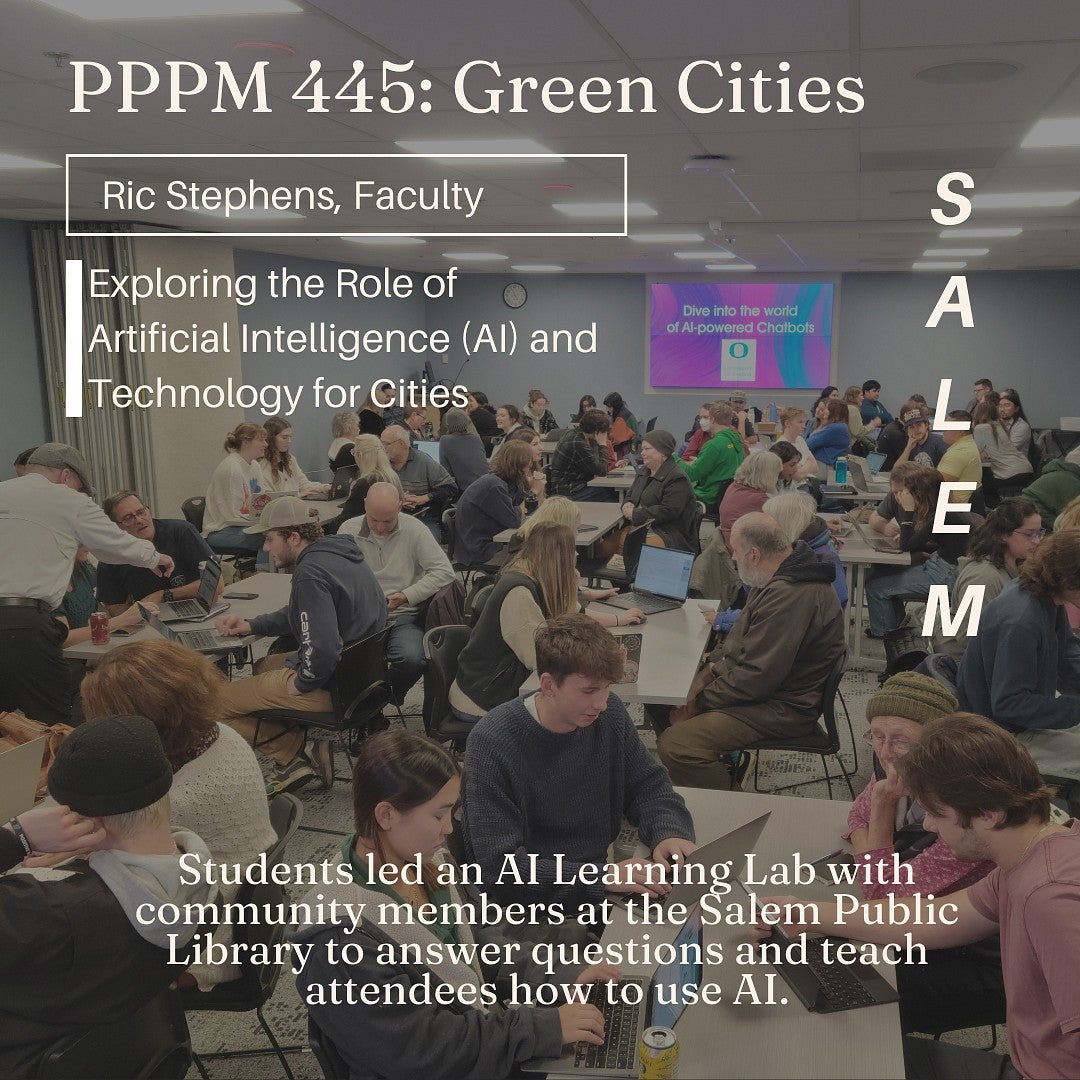
Faculty: Ric Stephens
Project: The Role of Artificial Intelligence and Technology for Cities
Outcome: While examining the history and future of the interface between urban growth and environmental concerns, and the technological, social, and political forces that continue to shape them, this course researched artificial intelligence (AI) and its relationship to cities, sustainable development, urban resiliency, and regenerative design. Students led a hands-on AI Learning Lab in partnership with the Salem Public Library to teach community members about the intricacies of refining large language models using specific prompts and recommended "Prompt Engineering". The students and Salem residents delved into the intricacies of refining large language models using specific prompts and recommended outputs.
The event showcased the students' creativity and adaptability as they employed ChatGPT utilizing prompts inspired by hypothetical instances and people. The students experimented with different tones, voices, and role assignments to study the impact on the generative capabilities of AI programs.
Sophia Sebastian, a fourth-year student majoring in Public Relations through the School of Journalism and Communications, participated in the Green Cities PPPM 445 class. “I found the event not only intellectually stimulating but surprising to know how much us college students knew about AI compared to the Salem residents,” said Sophia. “With AI being fairly new, my classmates and I did not know an extreme amount about AI prior to Ric’s class. I have not only learned about how AI works on a coding level, but I have a clear understanding of what I can envision it to do for us in the future.”
The engagement between UO students and Salem residents exemplified a commitment to community-driven education, a core principle of SCYP. Students participating in the event found it to be incredibly rewarding to teach the Salem community about AI as most of the participants were older who know very little about basic technology.
Sophia partnered with Julie, a retired Salem resident who loves to take road trips with her grandchildren and wants to know more about new-age technology.
"The interactions with students is my favorite part,” Julie said. “I have a better understanding with what AI can do and I feel more comfortable with it, and I think it’s something I can use in my everyday life to explore different options for communications and things that I’m interested in.”
The success of this AI outreach event exemplifies the importance of bridging academia to help strengthen and impact Oregon communities.
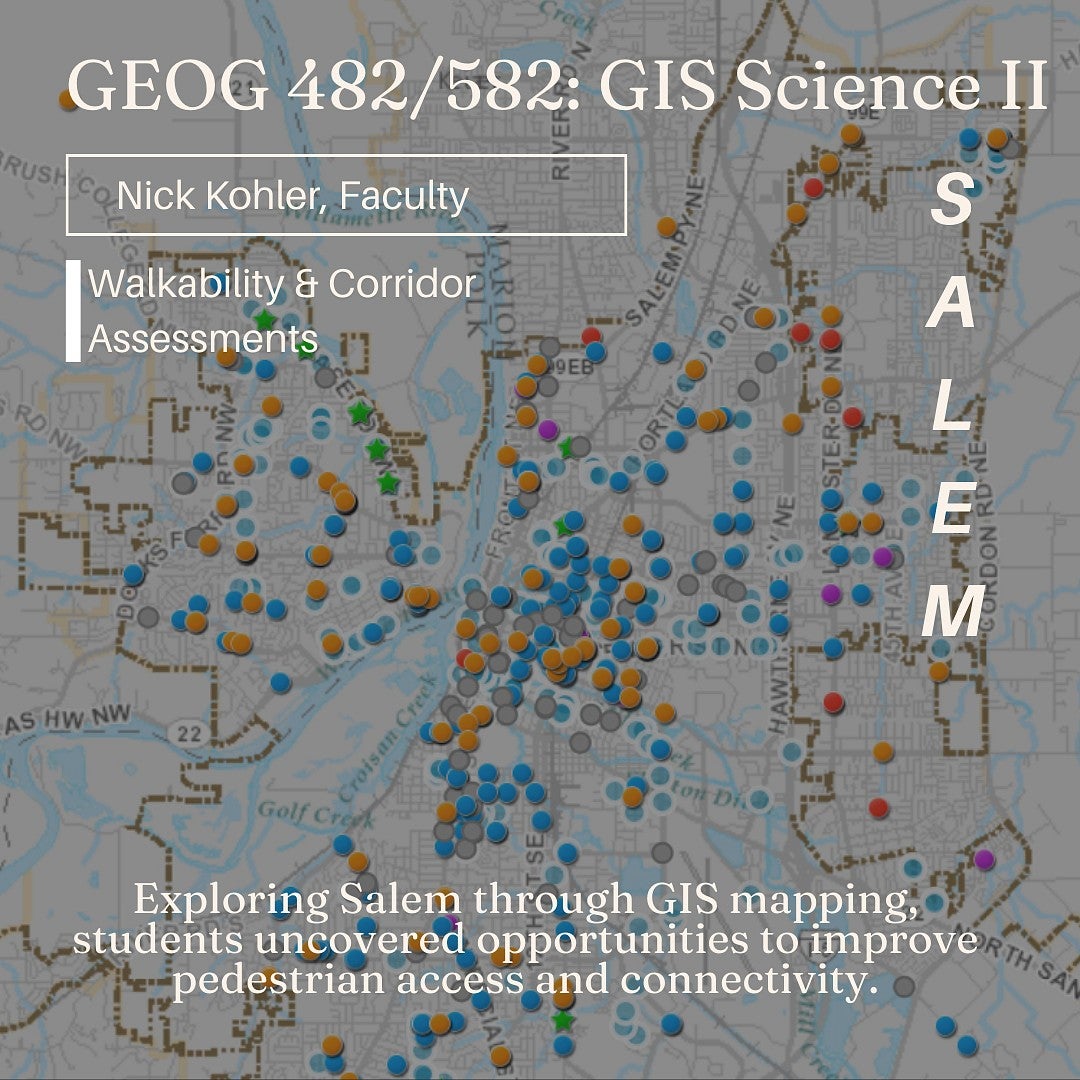
Faculty: Nick Kohler
Project: Walkability and Corridor Assessments
Outcome: Using GIS mapping, students identified sidewalk and pedestrian-centered area gaps or redundancies, as well as possible connections that could reduce gaps. Students also surveyed and assessed a selected corridor, which included an equity and demographic analysis, a network connectivity analysis, and/or a land use analysis, followed by specific recommendations related to the corridor. Students presented nineteen unique assessments and recommendations to City staff, ranging from pedestrian and bicycle safety, sidewalk accessibility and quality, equity, and walkable neighborhoods.
Over winter term 2024, phase two of the project will continue through another section of the course to provide city staff a deeper analysis on three priority locations and topics. A student from this course was also selected and received funding through the College of Arts and Sciences to intern with the City of Salem to identify and ground truth regions of Salem where new sidewalks, green spaces, bike lanes, and lighting would be most beneficial to improve pedestrian and biking safety. A GIS equity analysis index will be developed and then ground truthing will be done to verify the data and confirm equity and accessibility considerations by generating an equity analysis index to ensure under-represented communities are receiving services. This project will expand and improve the pedestrian experience, as well as promote emission-free transportation, all to make Salem more sustainable.
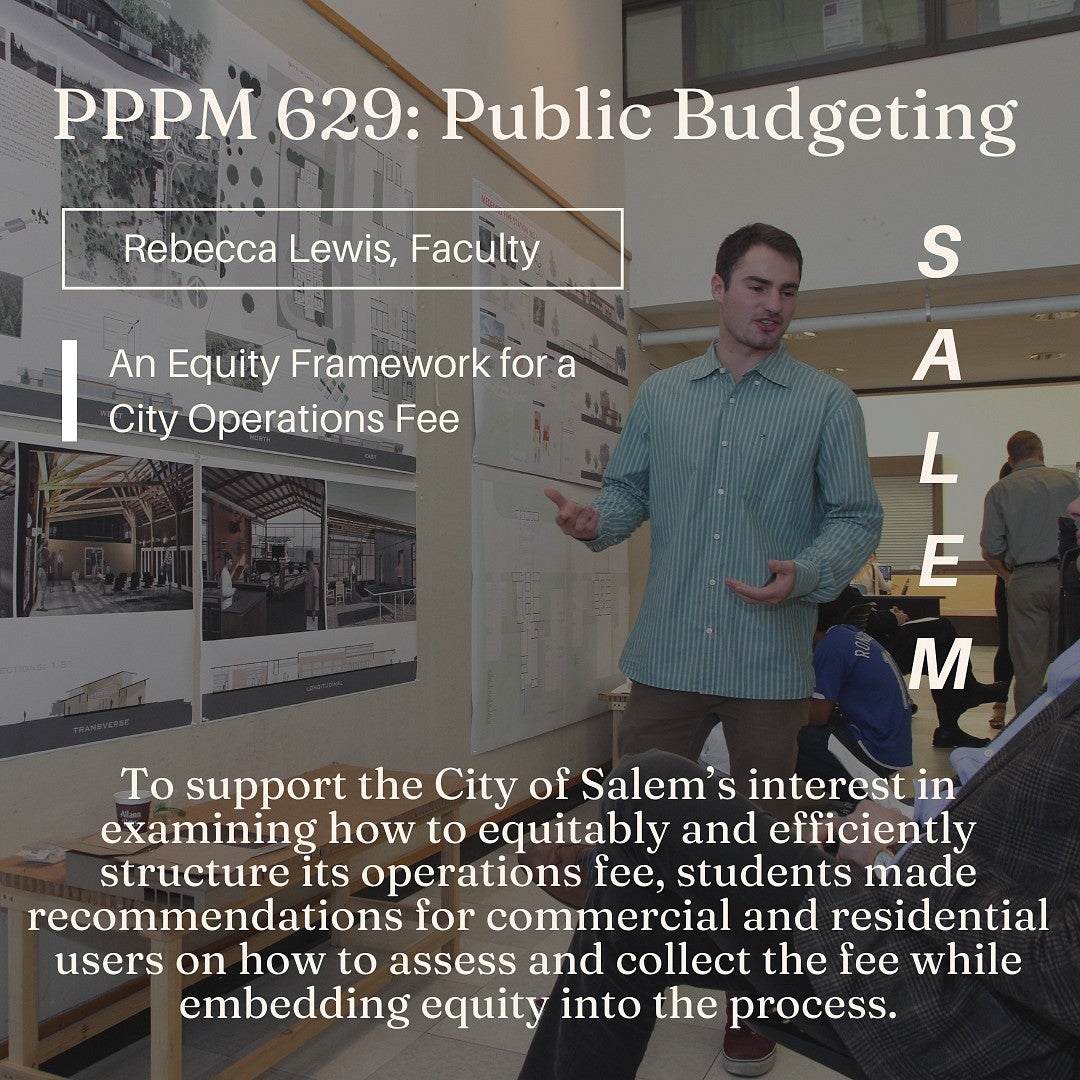
Faculty: Rebecca Lewis
Project: City Operations Fee Evaluation
Outcome: The City of Salem is interested in examining how to structure its operations fee, including how to assess and collect the fee equitably and efficiently in a way that embeds equity into the fee’s collection. The city wanted student input as it updates its 25-year-old software that collects the operations fee, which shows up on city utility bills, as the current organization of customer classes is limited by the system. City staff felt the challenge was prime for student learning and innovation, while helping the city to better understand how to apply equity within the structure.
Students grappled with the complexity of the project goals including considerations such as balance among user groups (commercial, industrial, institutional, public, residential) and within residential types (single family, multi-family). Four student teams made recommendations about the structure and collection of the fee, and evaluated whether the methods considered are equitable, efficient, neutral, productive, certain, and convenient. Students appreciated the opportunity to present their findings to city staff and noted the complicated challenges staff face in city planning. Students valued the opportunity to apply what they were learning in class and understand the impacts and tradeoffs of budget decisions.
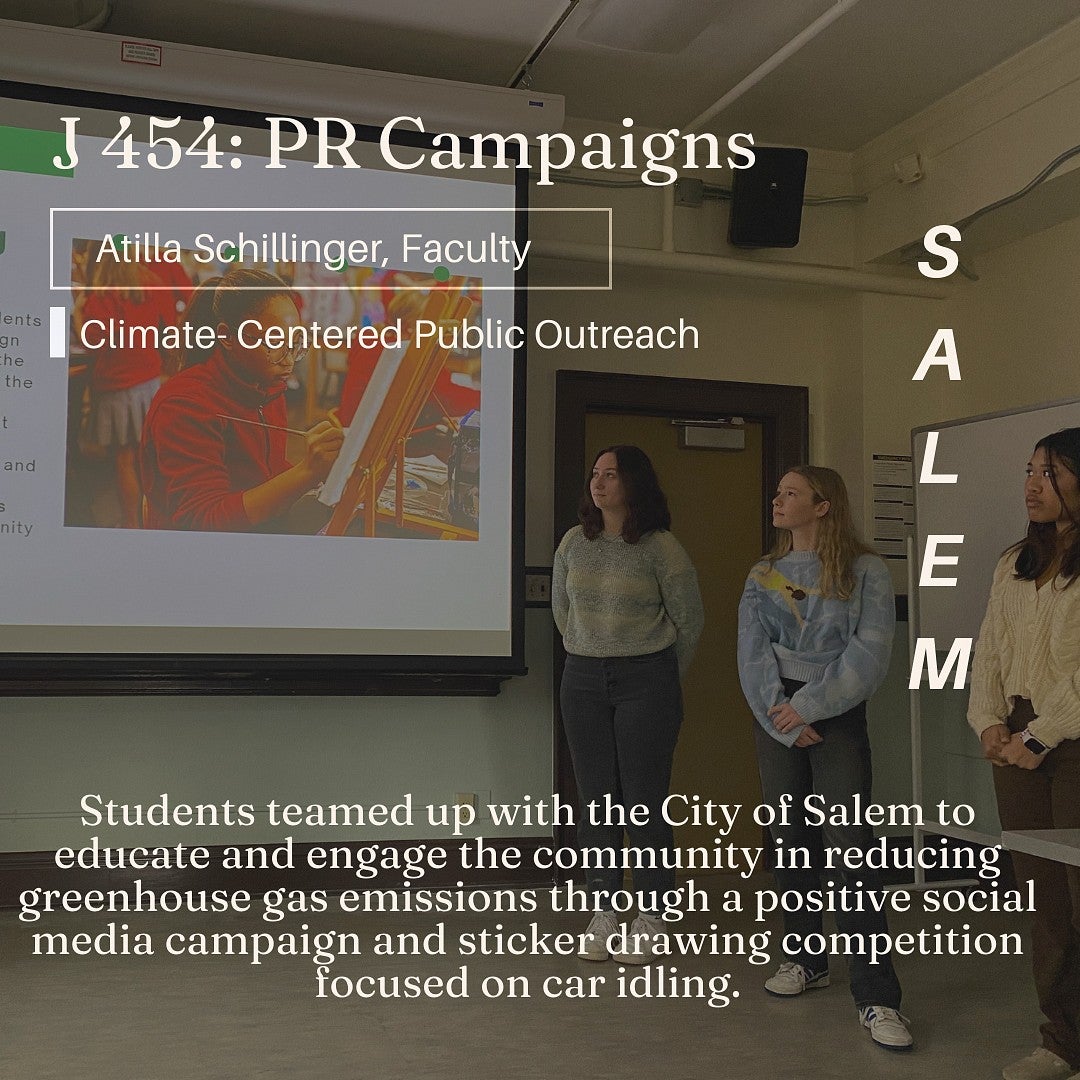
Faculty: Attila Schillinger
Project: Climate-Centered Public Relations Outreach
Outcome: A student team worked with the City of Salem to develop a positive community education campaign focused on “The Lowest Hanging Cherry – Stop Idling.” To move the city’s Climate Action Plan forward to reduce greenhouse gas emissions, students focused on an achievable task based on research of Salem city staff and residents’ behavior.
The students focused on developing simple positive messaging of taking action to stop idling that could have a huge impact on the community – starting with a defined focus and strategies to include:
- City employees leading by example through employee training sessions and communications efforts.
- Educating youth, who in turn can help influence their parents/guardians, through school assemblies and a sticker drawing competition in partnership with local businesses.
- Spreading awareness on the health risks associated with vehicle idling.
City staff are excited to implement the students’ ideas as their work included a full budget and measurement to assess the campaign’s impact. Students noted that it was a pleasure to get to know the city and its people and appreciated the trust in their team to work towards a more sustainable Salem.
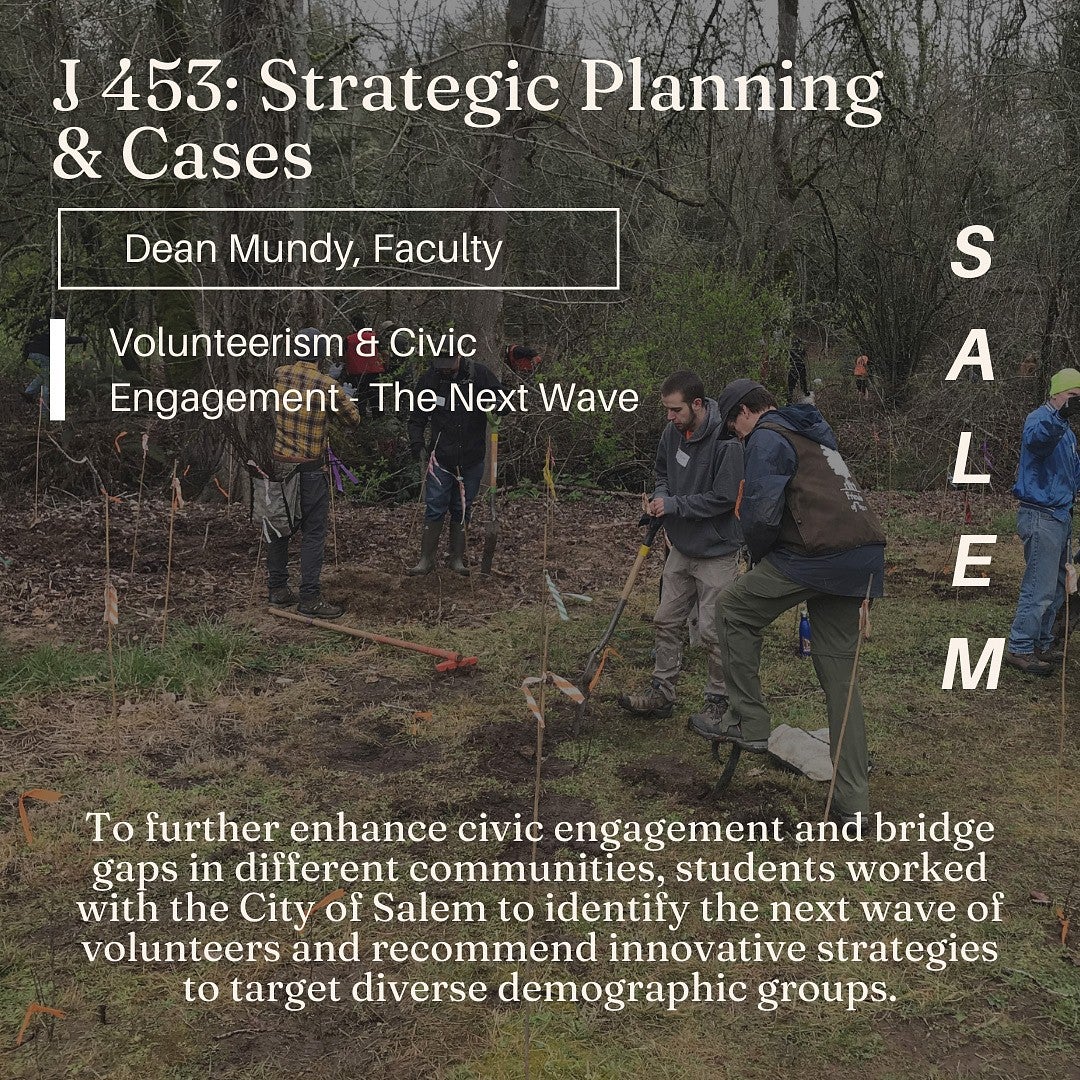
Faculty: Dean Mundy
Project: Volunteerism and Civic Engagement – The Next Wave
Outcome: Volunteers play a vital role in the City of Salem, from the mayor and city council to volunteer boards and commissions. To further enhance civic engagement and bridge gaps in different communities, journalism students worked in five project groups each focused on a distinct target audience to highlight innovative ways to engage different demographic groups, from spreading the "WOW" factor to bridge generational- and neighborhood-government gaps to a GenZ-branding guide to attract youth volunteers.
Student Project Team Recommendations:
Each groups recommended strategies to engage volunteers now and into the future.
Group 1: Spreading the "WOW" Factor
This group focused on bridging the gap between the north/northeast neighborhoods and city government to tackle potential mistrust. They proposed using the Center 50+ WOW Van (Wellness on Wheels) to create community and connection with residents utilizing empty nesters to provide mentorship to high school students that are providing tech support to older adults.
Group 2: Improving Civic Engagement of Youth and Underrepresented Communities
Recognizing the difficulty that youth and underrepresented communities may face in navigating the City of Salem’s website, this group proposed partnering with local universities and public policy majors to organize internships and volunteer opportunities. They suggested conducting volunteer "pitch" competitions and intercept interviews on campus to increase engagement. Students recommended a tailored website for students and a strong presence on multiple social media platforms.
Group 3: Sheltering Crisis
Aware of the potential negative opinions surrounding the city's handling of the sheltering crisis, this group aimed to address the concerns of the 18-24 age range, which constitutes 10% of the population. To improve perceptions, they suggested creating a Service in Salem Instagram account and utilizing hashtags such as #salemservicestories. The group also emphasized using GenZ colors, fonts, and language in their communications to resonate with this demographic.
Group 4: Hispanic Community and GenZ
Recognizing the desire of the Hispanic community and GenZ individuals to be civically engaged, this group proposed conducting an interest survey to identify community needs and preferences. They recommended leveraging existing community-based events, such as Hispanic Heritage Month, to create engagement opportunities. in addition, students proposed strategies such as establishing a Latino Business Alliance spokesperson and launching a Ciudad de Salem Instagram to reach these demographics.
Group 5: 23–38-Year-Olds/Families
Understanding the importance of building community and engaging families, this group proposed partnering with churches and schools to improve family messaging. Students proposed park beautification events involving families and children to create a sense of pride and belonging within the community.
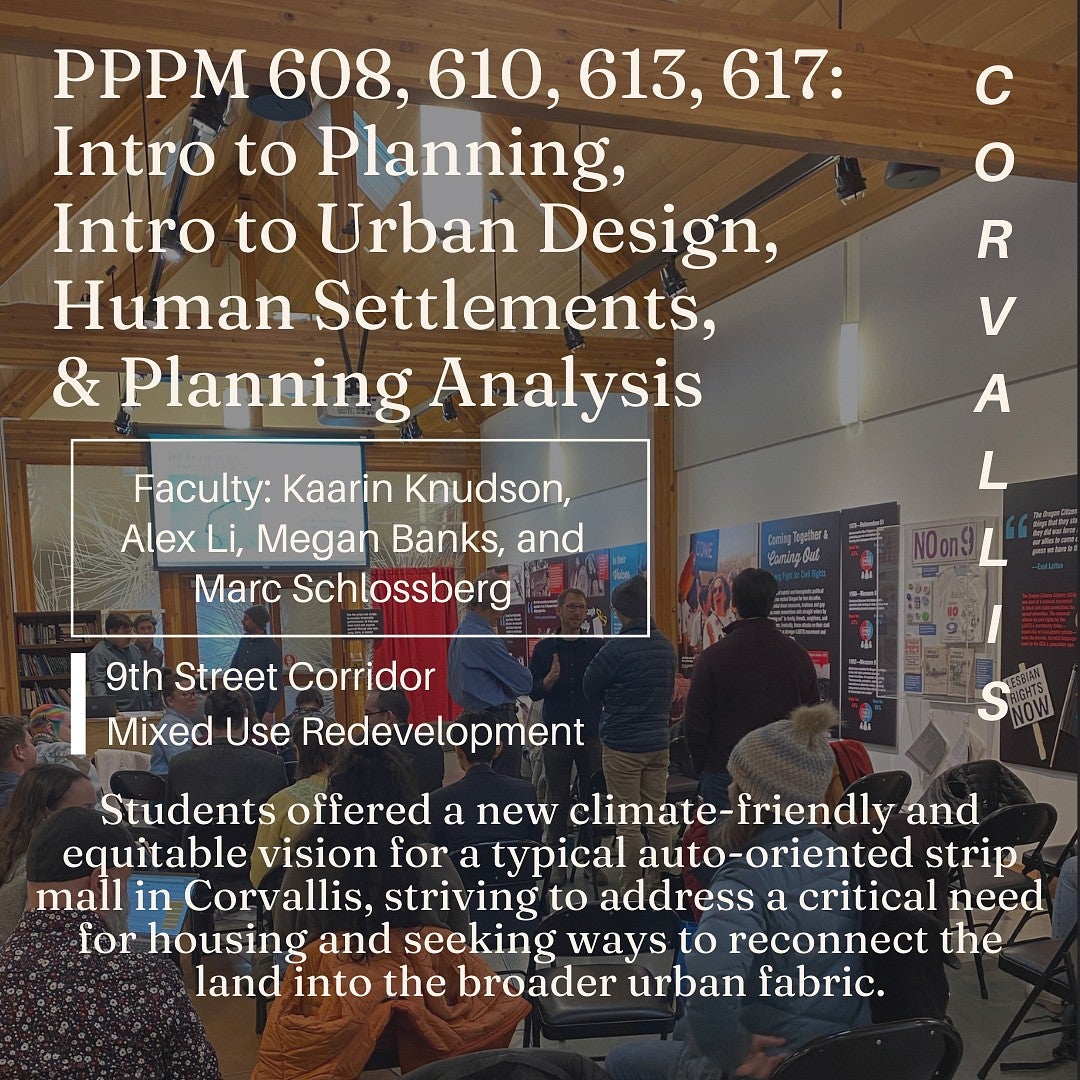
Intro to Planning, Intro to Urban Design, Human Settlements, and Planning Analysis
Faculty: Kaarin Knudson, Alex Li, Megan Banks, and Marc Schlossberg
Project: 9th Street Corridor Mixed Use Redevelopment – City of Corvallis
Outcome: Community and Regional Planning graduate students applied climate-friendly and equitable communities principles and concepts to a special project for the City of Corvallis, reimagining the future of a recently rezoned area of land in the city. Students considered how properties within this 14-acre automobile-centered, strip commercial area might redevelop and/or intensify under the city’s new zoning standards, which promote mixing uses and easier access for all transportation modes. Student groups framed site proposals within three potential themes, culminating in an urban design proposal and vision as well as policy recommendations to support the students' site-based recommendations. Specific themes and corresponding ideas include:
- Equitable Community: Students proposed row houses and mixed uses to create a strong street edge while locating active plazas and flexible spaces intended to foster an engaging interior environment. Their redesign of 9th Street emphasizes wider, greener sidewalks; safer biking conditions; and more comfortable bus stops. Equity is centered with a focus on accessible design principles and higher density housing of differing sizes.
- Walkable Neighborhoods: A pedestrian-only “promenade” anchors the site and allows pedestrians to enjoy car-free movement through the proposed development. Proposed site amenities include public art, greenery, outdoor restaurants and cafes, small parks with water features and playgrounds, and a larger plaza. In addition, fewer curb cuts, a new cycle track, and dedicated bus lanes on 9th Street promote a more walkable neighborhood.
- Climate Resilience: To increase the safety of residents in the event of a natural disaster, create spaces to build social capital, and limit greenhouse gas emissions, students proposed public transit and walkable spaces, a variety of building and unit types, diverse public spaces, and resilient-centered building methods.
First year graduate student Sienna Fitzpatrick shared her experience stating, “What a way to start grad school! My classmates and I had the privilege of studying Corvallis and offering creative solutions for the future of a newly rezoned parcel of land in the city, applying the principles and concepts of planning we've learned over the last ten weeks. Sustainable City Year Program is such an incredible way to learn, and one of the big reasons why I chose to come to the University of Oregon - because the faculty and students want to make a real impact on the world.”
